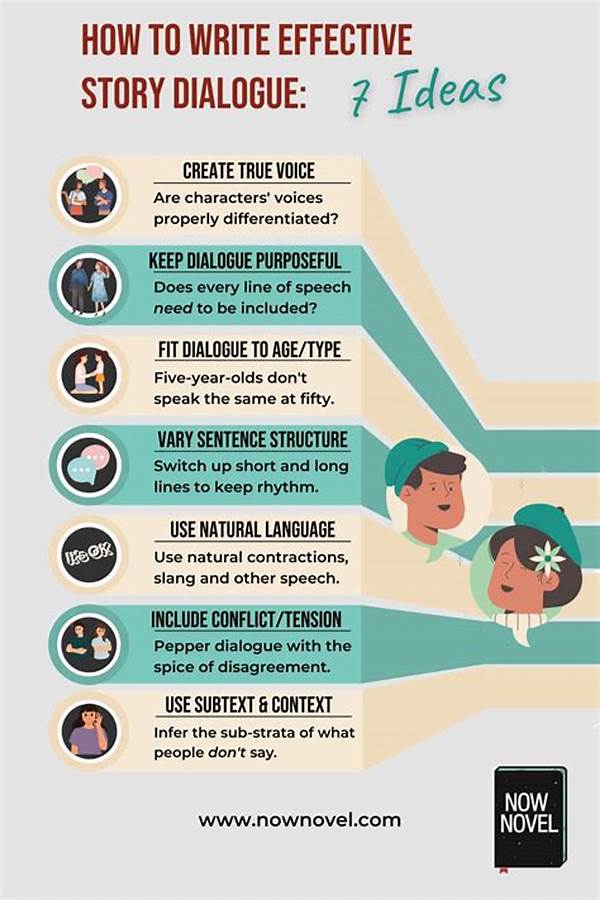Understanding the Art of Natural Dialogue
Creating natural dialogue in stories is a crucial element that can bring characters to life and make narratives more engaging. When readers feel like they are eavesdropping on real conversations, it draws them deeper into the story. To achieve this, writers must focus on crafting dialogue that flows seamlessly, reflecting how people genuinely communicate.
The key to creating natural dialogue in stories is to ensure that each character’s voice is distinct and consistent with their personality, background, and motivations. This involves paying attention to the nuances of everyday speech, such as colloquialisms, interruptions, and informal expressions. A character from a small town might speak differently from a bustling city dweller, and these differences should be reflected in their dialogue.
Moreover, natural dialogue often includes unspoken aspects, such as pauses and subtext, which can convey emotion and tension beyond the words themselves. By focusing on these elements, writers can create dynamic interactions that feel authentic and keep readers invested in the storyline. Creating natural dialogue in stories requires an ear for genuine conversation and an understanding of how dialogue can reveal character and advance the plot.
Techniques for Crafting Authentic Dialogue
Creating natural dialogue in stories involves several techniques that can enhance authenticity and believability. First, listen to real conversations. Observing how people speak can provide insights into natural speech patterns.
Incorporating realistic interruptions and overlaps can add authenticity. Human conversation is rarely straightforward, and including these elements can make dialogue more dynamic.
Using informal language and slang where appropriate can help characters sound more authentic. However, it should always be consistent with their background and personality.
Allow characters to have unique speech patterns. Each individual should have a distinct voice that sets them apart from others in the story.
Finally, remember that less is often more. Efficient dialogue that gets to the point without unnecessary detail keeps the story moving and holds the reader’s attention.
Dialogue as a Tool for Character Development
Another essential aspect of creating natural dialogue in stories is its role in character development. Dialogue provides an opportunity to reveal a character’s personality, thoughts, and emotions in a way that traditional narrative might not capture as effectively. Through their words, a character’s priorities, values, and potential conflicts can be revealed.
In creating natural dialogue in stories, dialogue can show a character’s internal conflicts or how they change over time. Subtle shifts in their speech can indicate growth, regression, or an internal struggle. For instance, a character might start using more assertive language as they gain confidence, or they might become more reserved following a traumatic event.
Moreover, dialogue can expose the relationships between characters. How characters speak to one another—whether with respect, disdain, affection, or sarcasm—can convey the dynamics of their relationships. Creating natural dialogue in stories, therefore, not only enhances the realism of the narrative but also serves as a powerful tool for character exploration.
Elements of Natural Sounding Dialogue
Using contractions and informal language is a hallmark of creating natural dialogue in stories. It reflects how people speak in everyday life, making characters relatable.
Creating natural dialogue in stories often involves a degree of imperfection. Real speech includes mistakes, repetitions, or unfinished sentences.
Characters should have varying vocabularies. A diverse range of language use can reflect different education levels or backgrounds, adding realism.
Even in fiction, silence is golden. Pauses or breaks in dialogue can build tension or denote contemplation, contributing to realistic interactions.
Finally, creating natural dialogue in stories requires brevity. Real conversations are often concise, with speakers getting to the point.
The Importance of Context in Dialogue
When it comes to creating natural dialogue in stories, context plays a pivotal role. Dialogue should be consistent with the setting and situations in which the characters find themselves. For example, the language used during a tense action scene might differ significantly from a casual dinner conversation. Context ensures dialogue feels appropriate and enhances the narrative’s believability.
Additionally, context influences the tone and style of the dialogue. In creating natural dialogue in stories, understanding how the surrounding environment or social situation impacts interactions can add depth and richness. A character might speak more formally in a professional setting, while using a relaxed tone amongst friends.
Furthermore, context provides an anchor for understanding subtext in dialogue. When characters speak in a particular setting or situation, their words may carry additional meaning influenced by previous events or the expectations of their surroundings. Crafting natural sounding context-aware dialogue ultimately creates authenticity and immerses readers within the story’s world.
Capturing Realism Through Dialogue
Creating natural dialogue in stories contributes significantly to a narrative’s realism. It bridges the gap between readers and characters, inviting readers to experience the story more fully. When dialogue feels authentic, it elevates the entire storytelling experience.
To capture realism, writers must pay attention to the rhythm and cadence of speech. This involves mimicking the natural flow of conversation, allowing for interruptions and overlaps. Additionally, using dialogue strategically to convey emotion and intent reinforces authenticity.
Furthermore, realistic dialogue results in believable character interactions. When characters speak in ways that align with their personality and situation, it enhances their relatability and engagement. Creating natural dialogue in stories is, therefore, essential in crafting an immersive, captivating narrative that resonates with readers.
